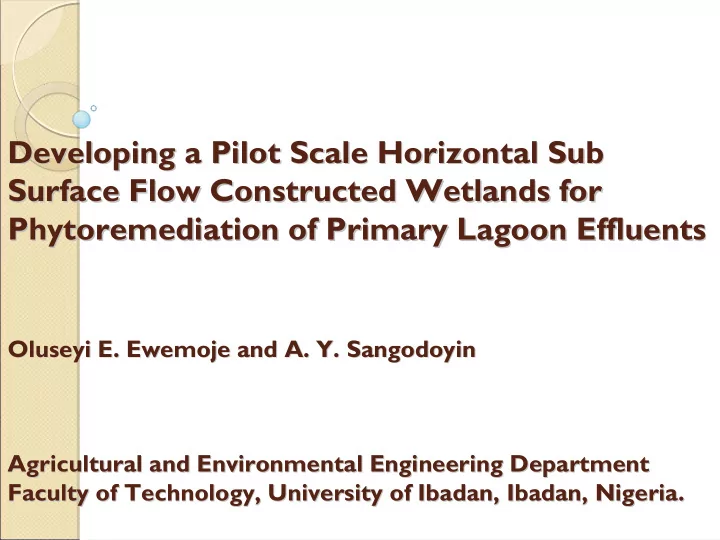

Developing a Pilot Scale Horizontal Sub Developing a Pilot Scale Horizontal Sub Surface Flow Constructed Wetlands for Surface Flow Constructed Wetlands for Phytoremediation of Primary Lagoon Effluents Phytoremediation of Primary Lagoon Effluents Oluseyi E. Ewemoje and A. Y. Sangodoyin Oluseyi E. Ewemoje and A. Y. Sangodoyin Agricultural and Environmental Engineering Department Agricultural and Environmental Engineering Department Faculty of Technology, University of Ibadan, Ibadan, Nigeria. Faculty of Technology, University of Ibadan, Ibadan, Nigeria.
Presentation Outline Presentation Outline � Introduction � Problem statement � Specific objective � Methodology � The design � Preliminary Results � conclusion
Introduction Introduction � Constructed wetlands � Alternative to activated sludge treatment � Low cost associated with maintenance, operation and energy requirement � Alternative to expensive chemical fertilizers � Conventional high-technology wastewater treatment system
Problem Statement: Problem Statement: � Treatment requirement � In developed countries, the goal is elimination of all pollutants � constructed wastewater systems are suitable since they can be efficient in removal of BOD 5 , pathogens and nutrients
The specific objectives The specific objectives � this study aims at developing a pilot scale horizontal subsurface flow constructed wetlands system for treatment of primary lagoon effluent (sewage) � To design, construct and conduct operational testing of horizontal subsurface flow treatment wetlands.
Methodology Methodology � Experimental set up would consist of 3 vegetated cells and 1 non-vegetated cell � Each bed will be X m long, Y m wide and Z m deep. Size of matrix of the SSHF to be constructed depends on influent - concentrations of the wastewater BOD 5 , TSS and N0 3 according to Metcalf & Eddy (2004), Katayon et al., (2008) � Treatment area would be packed with 5-10mm ф pea gravel while 20-50mm ф will be used at inlet and outlet � Surge tank of 1000l capacity will receive wastewater while 2 settling tanks of 500l capacities each would be connected to surge tank
Methodology Cont’ ’d d Methodology Cont � The Design: � The design of constructed wetlands has been carried out with different models � This study applied the “rule of thumb”. Though it is a conservative design model, easily applicable and can guarantee good quality effluents, it tends to increase the investment costs
Figure 1: Anaerobic Lagoon for Sewage Treatment Figure 1: Anaerobic Lagoon for Sewage Treatment
Preliminary Results Preliminary Results � Preliminary study on the primary lagoon effluents showed the following physico-chemical and microbiological parameters (Table 1) of treated sewage wastewater Table1: Characteristics of the Primary Lagoon Effluents Effluent Ranges FEPA Limit Parameter 420 – 450 80 COD 245 – 287 30 BOD 5 3050 – 3165 - Total Solid 1050 – 1160 2000 Total Dissolve Solid 1997 – 2005 20 Suspended Solid 95 – 193 - Turbidity ((NTU) 2.2 - 3.3 500 Total Coliform Count (cfu/100ml) 200 – 215 - Ammonia 103.5 – 110 20 Nitrate Source: Ewemoje and Sangodoyin (2009) All parameters in mg/l except where stated
� Rule of thumb according to Vymazal (2008) gave: = − ( ) / A Q InC InC K h d in out BOD Where; A h is surface flow of bed (m 2 ); Q d is average flow (m 3 d -1 ); C in is influent BOD 5 (mg l -1 ); C out is effluent BOD 5 (mg L -1 ); and K BOD is the rate constant (md -1 ). � Therefore, A h = 5.08m 2 PE -1 � However, Fowler (2003) gave: Area = 3W 2 � Therefore 5.08 = 3W 2 ; W = 1.30m � W currently being used is less than 1 (Vymazal, 2008) Hence a W value of 0.75m is chosen , for ease of construction, with a surface area of 2.25m 2 for effective BOD 5 removal (Katsenovich, et al., 2009) � Thus actual area of wetland designed is 2.25m 2 (i.e. 0.75 x 3.0m 2 )
Conclusion Conclusion � This is an ongoing first year PhD research work and design considerations with wetlands treatment bed size matrix which is one of the set out objectives has been achieved.
Thanks for listening
Recommend
More recommend